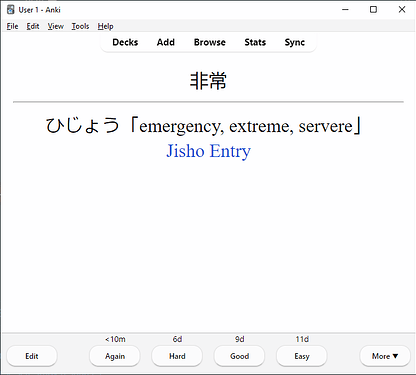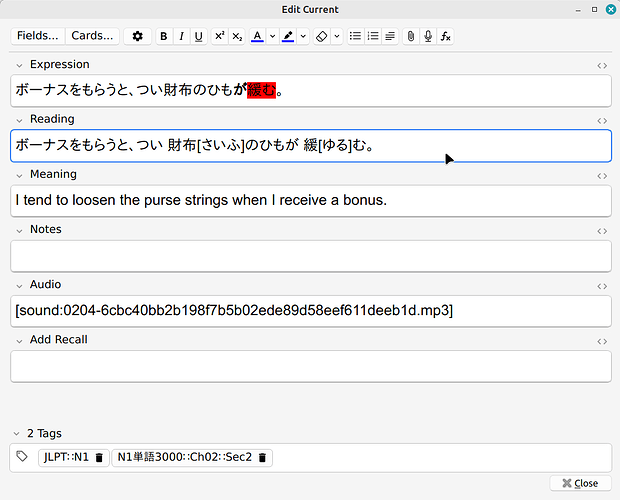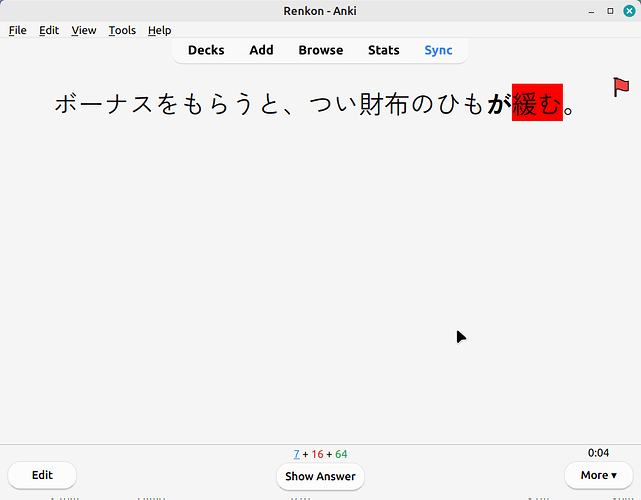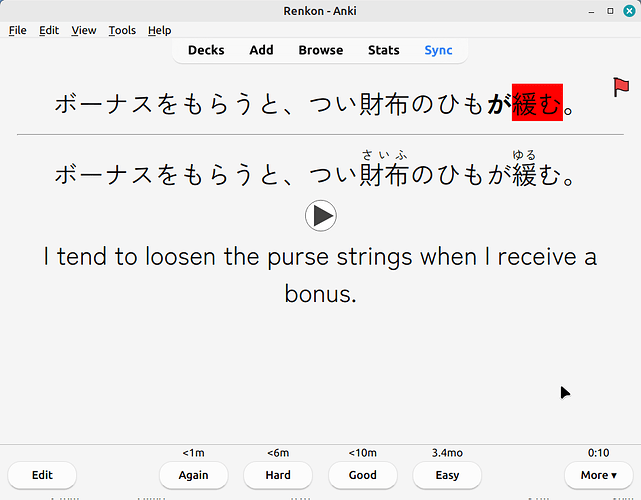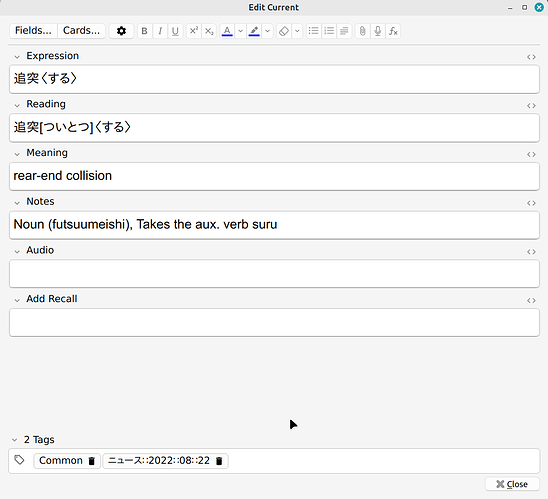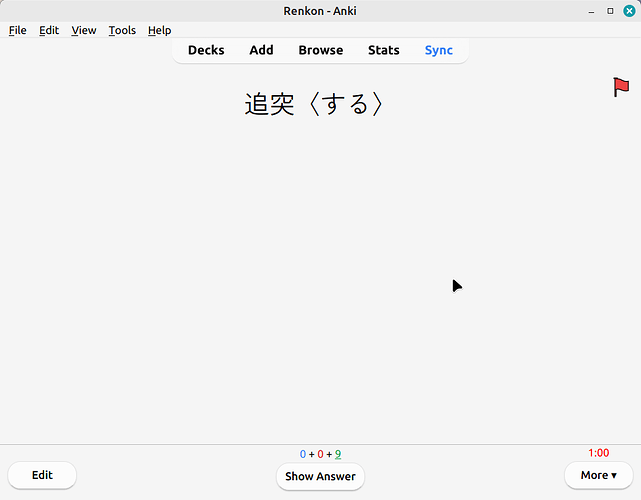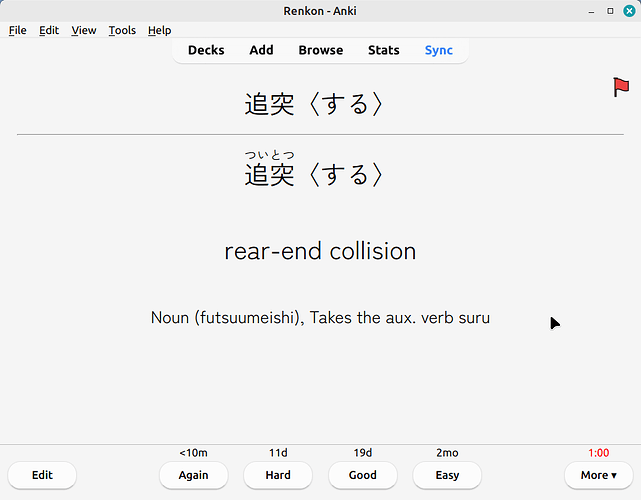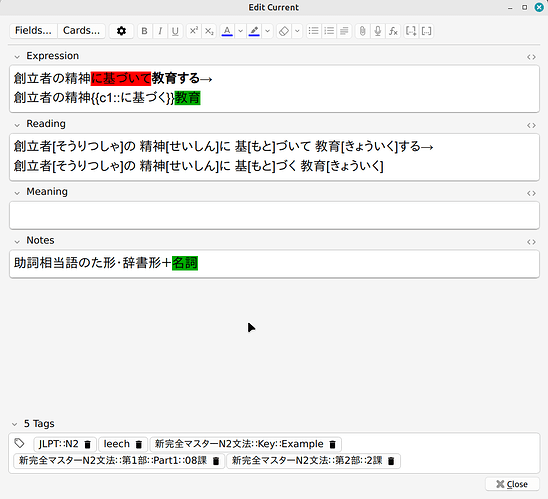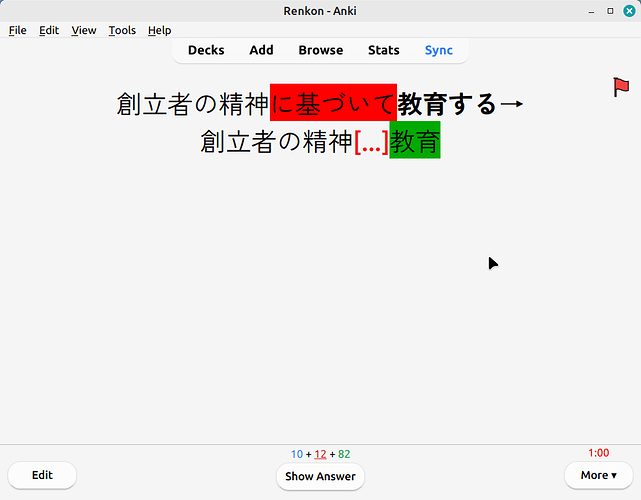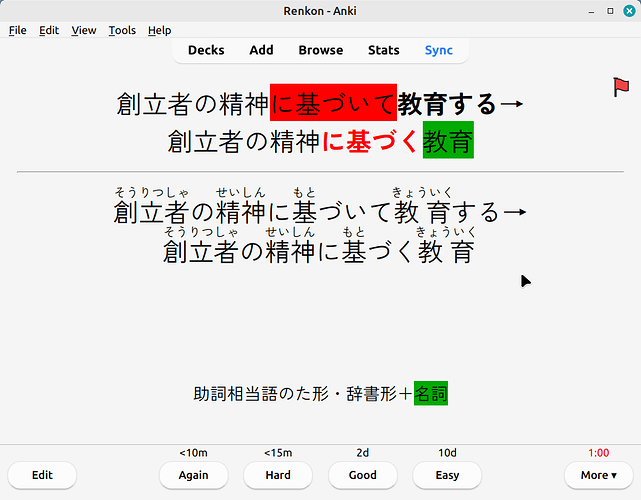It is the start of 2025 and you want to learn Japanese through self-study but have no idea where to begin! Here is what I did to teach myself Japanese starting in my mid-20s (i.e. after I graduated and had already entered the work force and was learning in my spare time). It’s not the perfect method, only you can find out what works best for you, but this at least should be a good starting place for folks interested in learning!
Step 1: Get Anki
I wrote a whole guide about it on my blog!
There are other SRS (spaced repetition study) and flashcard apps, but IME Anki is the most flexible. Even if you’re not studying Japanese, I recommend Anki if you’re looking to memorize lots of info (when I was in uni, I used it for basically ALL of my subjects). It’s free on PC and on Android (as Ankidroid) but I believe you have to pay on iOS. I forget the price but IIRC it is a one-time payment and cheaper than most textbooks, so I highly recommend it anyway.
Step 2: Learn hiragana/katakana
Get off of romaji IMMEDIATELY. The way I did this was buy a lot of notebooks and practice writing out the characters over and over, and then start writing vocabulary using hiragana/katakana instead of romaji, and then entire sentences/dialogues. (I’ll talk about textbooks below that I used for this, but there are plenty of resources, including shared Anki decks and the like.) The sooner you wean yourself off of using romaji, the easier it will be to look stuff up and understand how onyomi/kunyomi readings work.
Step 3: Learn to sightread kanji characters by identifying radicals
I can only speak for myself, but the most demoralizing part of learning Japanese was seeing a big block o’ kanji and hitting a wall. My mind would shut down because I could not even begin to pick apart what I was looking at. It’s a bit like trying to learn English by reading a novel before learning the alphabet.
I personally used James Heisig’s Remembering the Kanji. You can get the fifth edition for free here:
The idea is to be able to recognize the different radicals of a character, give them a mnemonic keyword, and then make stories for the character using those radicals. For example: a KING 王 under a ROOF 宀 holding a jewel that looks like a tear-DROP 丶 that is his TREASURE 宝.
If you go with RTK, I also recommend using Kanji Koohii to look up other user-made mnemonics, tho HUGE ASTERISK, a lot of the stories are like. gross racist/misogynist/etc shit ![]() But sometimes it can give you hints on what mnemonic story to make if you’re stuck on one.
But sometimes it can give you hints on what mnemonic story to make if you’re stuck on one.
If you do go with RTK, I DO NOT RECOMMEND GETTING THE SECOND VOLUME, and instead learn vocabulary and onyomi/kunyomi readings somewhere else. I used the Kanji in Context textbook and two workbooks in tandem with RTK and highly recommend that instead. This gives you vocab and example sentences for each kanji character, and is perfect for inputting into Anki:
If you are on Android I HIGHLY recommend Chase Colburn’s Kanji app. It’s not free and the add-ons are kind of pricey (tho IMO you only really need the Self-Study Upgrade, plus the Guided Study add-on if you don’t want to make your own kanji practice cards in Anki) but worth it just the same. It can also export notes into Ankidroid:
The Kanji Study app lets you organize characters in order of both RTK and also Kanji in Context, which makes it an excellent companion app if you plan to study with those. (It also does this for the Kodansha Kanji Learner’s Course, see below)
Other options besides RTK
If you don’t want to go with RTK (and like, I get it, it isn’t exactly a sleek all-in-one package), you can try WaniKani which uses the same basic idea of radicals + telling mnemonic stories. That has a subscription but I’ve had friends tell me it’s worth it to have it all pre-made and digital:
Another one I’ve heard very good things about is the Kodansha Kanji Learner’s Course:
And as mentioned, the Chase Colburn Kanji Study app lets you organize kanji in order of the KLC, so I highly recommend getting that as a companion app for your Android phone.
IMPORTANT POINT: Whether you go with RTK, WaniKani, or KLC, choose one and STICK WITH IT. I don’t recommend changing partway through because you feel it’s too slow or you’re falling behind on your backlog or whatever. They all use slightly different mnemonics so rather than confuse yourself (and also resetting all of your progress) I recommend not caring too much about having a large backlog and just tackle however much you can when you can. The important thing is regular review, not Backlog Zero.
Why learn kanji radicals before Japanese?
As I mentioned above, trying to learn Japanese without being able to mentally break apart each kanji character into their radicals is like trying to read English words before learning the alphabet. You can do it, but it’s a LOT harder to look up words you don’t already know (and requires you memorizing what every single English word looks like, rather than just the 26 letters and how they combine together).
The above methods are to 1) teach you the “alphabet,” i.e. the different radicals of a kanji so that you can use them to look them up in your kanji dictionary of choice if you run into a character you don’t already know 2) to be able to visually pick apart that, for example, 雲 雪 and 雷 are all different characters but probably have something to do with “weather,” and 3) most importantly, to sightread this stuff VERY QUICKLY so that you’re not having to stop and think with every. single. kanji. on. the. page. Getting your Japanese reading speed up to roughly your English reading speed (or whatever your first language) is A REALLY GOOD FEELING, and idk about you but that makes me excited to read more stuff ahahaha
Step 4: Load up on everything else
You learn vocabulary by seeing them in sentences which also helps you understand grammar which also increases your reading comprehension and improves your kanji sightreading, etc etc. This is the step you will be at for the rest of your language-learning journey lol. Just get your hands on as much Japanese material as you can and practice every day.
Just starting out
I liked the Genki series, tho it’s geared for classroom settings (so there are exercises that assume you’re doing them with a partner, etc). If you don’t mind that and/or can find someone to study with you, they’re a solid entry point:
I know the Minna no Nihongo series is pretty popular as well:
Studying for JLPT
If you are studying specifically for JLPT I used the 新完全マスター series, tho NOTE that it is all in Japanese (including explanations) so it can be a pretty steep for beginners. I recommend only getting the Grammar 文法 and Reading 読解 and skipping Vocab and Kanji, and only get Listening if you plan to do JLPT.
If you prefer English explanations for stuff and/or want LOTS of practice questions, I really like the JLPT “best” series of books by the Japan Times. I haven’t tried the “mini-stories” vocab books, but the main textbook (the one with three full practice tests) and workbooks are excellent.
I also quite like the Ask series of JLPT vocab books as a nice vocab supplement. Handy pocket size, plus audio files that you can throw into your Anki decks and link where you can download PDFs of vocab quizzes. These come with English explanations:
https://ask-books.com/series/hajimete-jlpt/
Beyond textbooks and tests
These days I mostly study by reading manga and news sites, and writing notes on stuff I don’t understand and looking it up later. If you’re on Android, the Takoboto dictionary app lets you make lists of vocab and then export them all into Ankidroid, super helpful for adding lots of notes when I am away from my computer:
If you want a good Japanese-Japanese dictionary, I like this one:
There are definitely good Japanese dictionary apps on iOS as well, ahaha.
NHK has near-daily news articles in “easy” やさしい Japanese, and you can toggle furigana on/off. They also highlight when a word is the name of a person, place, or company. They USED to also sometimes have little breakdowns on vocabulary/grammar points in the article itself, but stopped doing that a few months back. Oh well, it’s still really good to have in your study toolbox:
For manga, I highly recommend slice-of-life or yonkoma (four-panel) series with furigana, tho honestly whatever series you like will be great. It helps SO MUCH if you are interested in whatever you are reading, and in my experience, manga and light novels are a better motivator to study than textbooks/news/etc, haha.
(If someone tries to give you shit for studying w/ manga and anime because you’ll learn ““weird”” Japanese, please tell them that this is literally how Japanese kids learn the language lmao)
As for listening practice, the world is your oyster!! Anime and J-dramas are great (again, slice-of-life stuff is GREAT and a popular genre so you have a wealth of options). One of the first shows I latched onto when moving here was the あさどら (“morning drama,” a ~15min drama that plays every weekday morning on NHK). The acting is really hammy which doesn’t make for like, riveting TV or anything, but it DOES mean I can pretty clearly hear what everyone is saying and can pick up from context what’s going on.
There are tons of Japanese TV shows that’s basically “celebrities wander around and talk to locals and eat a lot of food” and those are INCREDIBLE for listening practice, especially since those also tend to put their captions up for like, comedic effect lol. (Side rant: wish Japanese CC was just a standard thing for ALL TV shows grrr.) When I was living in Hawai’i, they’d play those shows all. the. time on KIKU-TV, I don’t know if that is a thing on the mainland/outside of the US. It’s not must-watch TV by any means, but it is nice to just have this stuff on in the background while doing something else.
Do you like watching speedrunners or Let’s Players? GOOD NEWS, Japan is a country full of nerds who love that shit too:
Not to mention all the Japanese YouTubers out there. As I said, the world is your oyster!! Find people talking about shit you are already interested in, but in Japanese! The best way to learn the language is to have regular contact with it, if you’re more likely to watch Japanese speedrunners than pick up your Genki textbook then go for it IMHO.
Other stuff I’ve tried
The So-Matome series for JLPT is a good alternative to the 新完全マスター above if you prefer English explanations. IMHO these books just aren’t as good, they’re a lot easier than official JLPT tests so I feel like these would leave you pretty underprepared, but if you are not terribly interested in JLPT then these should be fine to get you started.
Just like the 新完全マスター series above, I recommend sticking to Grammar + Reading only. The reason why is because you are already learning kanji with RTK+KIC or whatever from Step 3, and vocab from your other sources. Pick up the Listening book if you are studying specifically for JLPT, but otherwise I wouldn’t bother.
Speaking of listening, I’ve used the Kuroshio New Shadowing series of books before, which I thought were just okay:
The conversations are kind of stilted and very much Textbook Japanese, which is helpful if you are studying specifically for a test like the JLPT, but not much else.
The Most Important Thing Of All
…is to learn Japanese. NOT to craft the most perfect efficient matrix of studying and resources. However you are already studying is probably fine, and you do not need to overhaul your study schedule/regiment every time someone (even me!!) recommends a new method. There is no perfect method! And even if there were, who cares!! Your goal is to LEARN JAPANESE!!!
I say this as someone who probably spent most of the past 15 years throwing everything out and starting from scratch. Don’t do that!! Just stick with it, add on with new resources and drop stuff that isn’t working for you, but don’t dump everything you’ve already got to start over from scratch, ahahaha. Your goal when setting up eg Anki should not be to own an immaculate collection of cards, it should be using it as a tool to LEARN JAPANESE. Don’t redo your entire collection because you thought of some better, more efficient way to organize your cards!! Again: PLEASE learn from my mistakes!! ![]()
